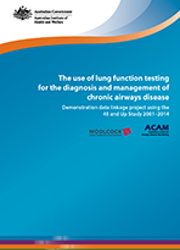Summary
This demonstration project highlights the value of data linkage for addressing population health questions related to chronic airways disease. It includes data from the Sax Institute's 45 and Up Study, a cohort study of people aged 45 and over living in New South Wales. Baseline questionnaire data from this study were linked to health-care utilisation data from the Medicare Benefits Schedule (MBS) and to medication dispensing data from the Pharmaceutical Benefits Scheme (PBS).
The study examined MBS and PBS claims for lung function testing as a potential indicator of the use of these tests in the diagnosis and management of chronic airways disease and also investigated these tests in primary (versus specialist) care.
Rationale
Spirometry is a type of lung function test that assesses how well the lungs are working. It forms an essential part of the diagnosis and ongoing management of chronic airways disease, since it measures expiratory airflow limitation. Australian guidelines for asthma recommend that spirometry be performed to confirm a diagnosis of asthma, preferably before treatment has started or soon after treatment has commenced. Spirometry is recommended every 1-2 years for most people with asthma as a tool in the ongoing management of the condition. Similarly, international and Australian guidelines for chronic obstructive pulmonary disease (COPD) consider objective testing with spirometry essential for the diagnosis of COPD and for assessing the need for inhaled corticosteroid therapy.
This project hypothesised that most people with asthma and COPD did not have their lung function measured to confirm the diagnosis or as a component of the ongoing management of their chronic airways disease, contrary to guideline recommendations.
Findings
Most people (81.6%) in the 45 and Up Study who were initiated on medications used in the management of chronic airways disease between June 2005 and December 2013 did not have lung function testing performed within 12 months, either before or after their initial prescription. Furthermore, among those respondents who reported having current asthma, lung function testing was only claimed for about one-quarter (26.2%) in a recent 3-year period and 12.3% had only 1 lung function test claim during that time.
Conclusions
Bringing together health-care utilisation and prescribing information with questionnaire data from the 45 and Up Study enabled exploration of research questions that were unachievable by analysing 1 data source in isolation. This investigation supports the hypothesis that lung function tests are under-used in New South Wales for the purposes of diagnosis and management of chronic airways disease. This may lead to inaccurate diagnoses of chronic airways disease and possibly to inappropriate prescribing of medications used in its everyday management. The under-use of spirometry observed in this study may, in part, reflect barriers to its use in primary care, including costs and difficulties in interpreting results.
With suitable linkage keys, similar methods could be used to explore anonymised linked data on a national level and could also be used to fill evidence gaps associated with other high-burden chronic diseases such as diabetes, cardiovascular disease, arthritis and cancer. This could provide valuable evidence for health policy and the quality use of medicines.



